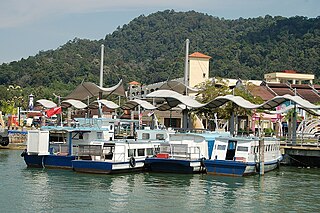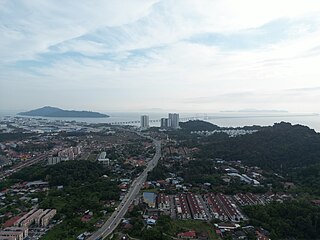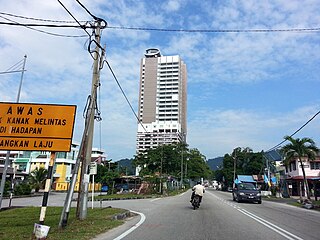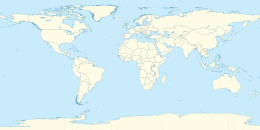
Sitiawan (alternate spelling: Setiawan; origin: from Malay, a portmanteau of SetiaKawan, meaning "Loyal Friend") is a mukim and town in Manjung District, Perak, Malaysia.

Lumut is a coastal town and mukim in Manjung District, Perak, Malaysia, situated about 84 km (52 mi) from Ipoh, 12 km (7.5 mi) from the town of Sitiawan and it is the main gateway to Pangkor Island before established Marina Island Pangkor as second gateway. It is noted for seashell and coral handicrafts. This once little-known fishing town has since become the home base of the Royal Malaysian Navy and the site of the biggest naval shipbuilder in Malaysia, Boustead.

Redang Island is an island in Kuala Nerus District, Terengganu, Malaysia. It is one of the largest islands off the east coast of Peninsular Malaysia and as well as one of the most beautiful islands in the world. It is famous for its crystal clear waters and white sandy beaches. It is one of nine islands, which form a marine sanctuary park offering snorkeling and diving opportunities for tourists.
Teluk Intan is a town in Hilir Perak District, Perak, Malaysia. It is the district capital and largest town in Hilir Perak district and fourth largest town in the state of Perak with an estimated population of around 172,505, more than half of Hilir Perak district's total population (232,900).

Seberang Perai is a city in the Malaysian state of Penang. It is situated on the Malay Peninsula opposite Penang Island, bordering Kedah to the north and east and Perak to the south. Its city centre is located in Butterworth, while its local authority, the Seberang Perai City Council, is centred near Bukit Mertajam. As of 2020, Seberang Perai had a population of 946,000, making it the third most populous city in Malaysia.

The Manjung District, formerly Dindings, is a district in the south-western part of the state of Perak, Malaysia. It is administered by the Manjung Municipal Council, formerly known as Manjung District Council from 1 January 1980 until 31 July 2001. The district is well known for Pangkor Island, an attraction in Perak and the home of the Royal Malaysian Navy (TLDM), Lumut Naval Base and dockyard. Dinding was once part of the British Straits Settlements colony. Seri Manjung is the district's principal urban centre while smaller towns include Lumut town, Sitiawan town, Ayer Tawar, Pantai Remis and Beruas.

Pulau Ketam is an island located off the coast of Port Klang, Selangor, Malaysia. The island is in the intertidal zone and the chief vegetation is mangrove.

Pulau Indah is an island in Klang District, Selangor, Malaysia with a population of around 20,000 people overall. Malaysia's largest port, West Port, Port Klang, is on the island.

Batu Maung is a residential neighbourhood in the Malaysian state of Penang. It is located 15.7 km (9.8 mi) south of the city centre, adjacent to Bayan Lepas and the Penang International Airport. Batu Maung is home to the island terminus of the Second Penang Bridge and the southern end of the Tun Dr Lim Chong Eu Expressway. It is also surrounded by fishing villages such as Permatang Damar Laut and Teluk Tempoyak.

Teluk Kumbar is a suburb of George Town within the Malaysian state of Penang. It is located about 17.8 km (11.1 mi) south of the city centre, at the southern coast of Penang Island between Bayan Lepas to the east and Gertak Sanggul to the west.
Lumut Bypass, Federal Route 100, is a highway bypass in Manjung district, Perak, Malaysia. It is also a main bypass to Lumut and Teluk Batik. The motorists will be using this road from Ipoh-Lumut Highway to Pangkor Island. The Kilometre Zero of the Federal Route 100 starts at Simpang Empat, Teluk Muroh junctions, at its interchange with the Federal Route 18, connecting Lumut to Sitiawan.

The Penang National Park spans 1,213ha of land and sea and is used by scientists, researchers, and nature lovers to explore its natural treasures.

The South-West District is a district within the Malaysian state of Penang. The district covers the southwestern half of Penang Island and borders the North-East to the north-east. It has an area of 175 km2 (68 sq mi) and a population of 197,131 as of 2010. Balik Pulau is the district's administrative centre, while Bayan Lepas is the largest town within the district.

The Dutch Fort is a fort in Pangkor Island, Manjung District, Perak, Malaysia. The ruins are the remnants of an outpost of Dutch attempts to control trade in the Malay peninsula. In the Malay language, the fort is called Kota Belanda. The Dutch called it Fort Dindingh, after the Dinding River, on the mainland of Perak.

BFM 89.9 is a Malaysian independent business and current affairs-oriented radio station.
Pasir Panjang is a state constituency in Perak, Malaysia, that has been represented in the Perak State Legislative Assembly.
Pangkor is a state constituency in Perak, Malaysia, that has been represented in the Perak State Legislative Assembly.
Dabus is a warrior dance from the Malaysian state of Perak. This warrior dance, as such, is characteristically heroic, demanding performers to exhibits traits of intelligence, dexterity, heroism, and cheerfulness when performing. Dabus is one of the traditional dances of Perak that has survived some 300 years. There are conflicting theories on the origin of Dabus, with some historians claiming that it was brought over from Aceh, while other historians believe it to have been brought over from Baghdad during the 18th century.























